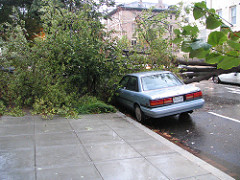There are countless poems and other verses about the beauty of trees. They can provide shelter, give fruit, and offer shade. Part of their beauty is in their powerful size, stretching to the sky and often much wider than an adult’s arm span. This is also what makes them potentially dangerous, potentially deadly. In some cases, property owners are responsible when a tree falls and injures or kills someone else. Do not assume you are without recourse if you or a loved one are the victim of a tree fall injury; read on for some general information and call our Northern California tree fall injury law firm in San Francisco, Santa Rosa, or Oakland to learn more.
Tree Fall Kills Driver in SoCal
According to the San Francisco Chronicle and the Associated Press, a motorist in Pacific Beach died Sunday when powerful winds knocked a tree onto a residential roadway. Fire Captain Joe Amador told reporters the tree measured eight feet in diameter and also crushed three unoccupied, parked vehicles. The storm’s strong winds knocked down dozens of trees throughout Southern California, even ripping up rooftops before continuing its journey up the coast.
 Applying Premises Liability Law to Tree Cases
Applying Premises Liability Law to Tree Cases
We have far too little information to make an informed legal judgment about the recent Pacific Coast tragedy. However, broadly speaking, most fallen tree cases are governed by premises liability law (often thought of in terms of “slip and fall” cases), a topic that falls under the broader rubric of negligence law. As detailed in the Section 1000 of the California Civil Jury Instructions (“CACI”), the basic claim that a plaintiff was injured because of the way the defendant managed his property requires showing:
- Negligence – The defendant negligently used or maintained the property
- CACI 1001 explains that a defendant “is negligent if he or she fails to use reasonable care to keep the property in a reasonably safe condition. A person who [owns/leases/occupies/controls] property must use reasonable care to discover any unsafe conditions and to repair, replace, or give adequate warning of anything that could be reasonably expected to harm others.” Relevant factors in the analysis include location, the likelihood someone would encounter the issue, the potential gravity of any harm, etc.
- As in many cases, the rule looks at what the defendant “knew or should have known.” Ignorance is no excuse if an ordinary person in the defendant’s situation would have been aware of the problem and had enough time to remedy it. Property owners are expected to make reasonable reviews of their property for possible dangers.
- Control – The defendant must have owned, leased, occupied, or otherwise controlled the property;
- Harm – The plaintiff was injured/harmed;
- Causation – The negligence above was a substantial cause of the harm.
Put simply: If the owner knew or should have known that a tree was a hazard and the owner failed to act, the owner is legally liable for any injuries or financial damages caused by a falling tree or tumbling branch.
A quick note: If you speak with people other states about premises liability law, you may find them emphasizing the terms “trespasser,” “invitee” (often a business-related entrant) and “licensee” (often a social guest). These terms address the status of the injured person. While this status can be part of the negligence evaluation and impact the reasonableness of the owner’s actions (i.e. one typically owes higher duties to someone who comes into a store to do business than someone who breaks in overnight!), this status is just one part of the calculation and is not controlling in and of itself as it is in some other states.
A Few Points on Trees: Ownership and Prevention
In California, Civil Code 833 that “Trees whose trunks stand wholly upon the land of one owner belong exclusively to him, although their roots grow into the land of another.” Property owners must be mindful of tree maintenance. Since we would always prefer to help prevent accidents (though we are very proud of our work helping people recover compensation after accidents!), we wanted to include a few words on tree maintenance.
Many common causes of tree collapse can be managed by being a good steward of your land. These causes include improper maintenance, failure to trim loose branches, improper planting/installation (e.g. planting where the roots will not be able to effectively anchor the tree or simply planting in an unwise location), and failure to spot/respond to disease. Owners/Occupiers must inspect their land to determine if any trees pose a hazard to guests or passersby, including risks that would only become reality in harsh weather. If a hazard is detected, the landowner must take precautions ranging from trimming branches, treating disease, and possibly removing the tree. Responsible property owners should regularly inspect their property and employ a certified arborist to look at trees annually.
Our Tree Injury Lawyer in Oakland, Santa Rosa, and San Francisco
If a tree fell and injured you or a family member in Northern California, you may have a legal claim. This is true whether the owner was a private individual, a company, or even a government authority (although claims against the government require some special procedural steps). Call our tree
See Related Blog Posts:
When Winds and Negligence Combine to Cause Injury to Northern Californians
Recovering Injury Compensation Following Mudslides
(Image by Ruid Rlet, not of incident discussed in article)
 San Francisco Injury Lawyer Blog
San Francisco Injury Lawyer Blog

